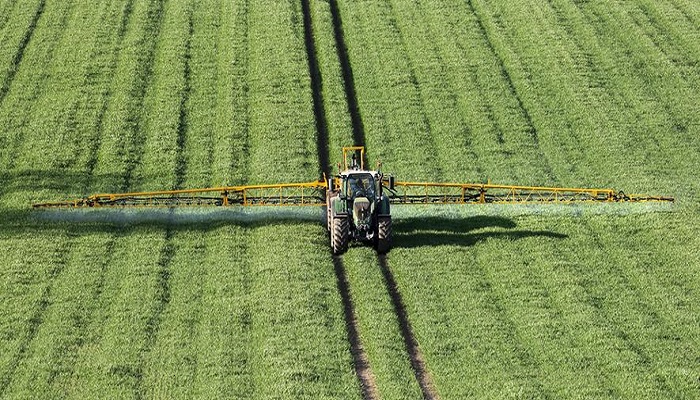The researchers, from the University of Cambridge, found that two-thirds of carbon emissions from fertilisers take place after they are spread on fields, with one-third of emissions coming from production processes.
Although nitrogen-based fertilisers are already known to be a major source of greenhouse gas emissions, this is the first time that their overall contribution, from production to deployment, has been fully quantified. Their analysis found that manure and synthetic fertilisers emit the equivalent of 2.6 gigatonnes of carbon per year – more than global aviation and shipping combined.
Carbon emissions from fertilisers urgently need to be reduced; however, this must be balanced against the need for global food security. Earlier research has estimated that 48% of the global population is fed with crops grown with synthetic fertilisers, and the world’s population is expected to grow by 20% by 2050.
The Cambridge researchers say that a combination of scalable technological and policy solutions are needed to reduce fertiliser emissions while maintaining food security. However, they estimate that if such solutions could be implemented at scale, the emissions from manure and synthetic fertilisers could be reduced by as much as 80%, to one-fifth of current levels, without a loss of productivity. Their results are reported in the journal Nature Food.
“Incredibly, we don’t actually know how many chemicals we produce globally, where they end up, where and how they accumulate, how many emissions they produce, and how much waste they generate,” said co-author Dr André Cabrera Serrenho from Cambridge’s Department of Engineering.
Serrenho and his co-author Yunhu Gao undertook a project to accurately measure the total impacts of fertilisers, one of the two main products of the petrochemical industry. Of all the products made by the petrochemical industry, the vast majority – as much as 74% – are either plastics or fertilisers.
“In order to reduce emissions, it’s important for us to identify and prioritise any interventions we can make to make fertilisers less harmful to the environment,” said Serrenho. “But if we’re going to do that, we first need to have a clear picture of the whole lifecycle of these products. It sounds obvious, but we actually know very little about these things.”
The researchers mapped the global flows of manure and synthetic fertilisers and their emissions for 2019, along all stages of the lifecycle, by reconciling the production and consumption of nitrogen fertilisers and regional emission factors across nine world regions.
After completing their analysis, the researchers found that unlike many other products, the majority of emissions for fertilisers occur not during production, but during their use.
“It was surprising that this was the major source of emissions,” said Serrenho. “But only after quantifying all emissions, at every point of the lifecycle, can we then start looking at different mitigation methods to reduce emissions without a loss of productivity.”
The researchers listed and quantified the maximum theoretical impact of different mitigation methods – most of these are already known, but their maximum potential effect had not been quantified.
Emissions from the production of synthetic fertilisers are mostly from ammonia synthesis, partly due to chemical reactions used in the production process. The most effective mitigation at the production stage would be for the industry to decarbonise heating and hydrogen production. Additionally, fertilisers could be mixed with chemicals called nitrification inhibitors, which prevent bacteria from forming nitrous oxide. However, these chemicals are likely to make fertilisers more expensive.
“If we’re going to make fertilisers more expensive, then there needs to be some sort of financial incentive to farmers and to fertiliser companies,” said Serrenho. “Farming is an incredibly tough business as it is, and farmers aren’t currently rewarded for producing lower emissions.”
The single most effective way to reduce fertiliser-associated emissions, however, would be to reduce the amount of fertilisers that we use. “We’re incredibly inefficient in our use of fertilisers,” said Serrenho. “We’re using far more than we need, which is economically inefficient and that’s down to farming practices. If we used fertiliser more efficiently, we would need substantially less fertiliser, which would reduce emissions without affecting crop productivity.”
The researchers also looked at the mix of fertilisers used around the world, which varies by region. The researchers say that replacing some of the fertilisers with the highest emissions, such as urea, with ammonium nitrate worldwide could further reduce emissions by between 20% and 30%. However, this would only be beneficial after decarbonising the fertiliser industry.
“There are no perfect solutions,” said Serrenho. “We need to rethink how we produce food, and what sorts of economic incentives work best. Perhaps that means paying farmers to produce fewer emissions, perhaps that means paying more for food. We need to find the right mix of financial, technological and policy solutions to reduce emissions while keeping the world fed.”
Serrenho and Gao estimate that by implementing all the mitigations they analysed, emissions from the fertiliser sector could be reduced by as much as 80% by 2050.
“Our work gives us a good idea of what’s technically possible, what’s big, and where interventions would be meaningful – it’s important that we aim interventions at what matters the most, in order to make fast and meaningful progress in reducing emissions,” said Serrenho.
The research was part of the C-THRU project, led by Professor Jonathan Cullen, where researchers from four UK and US Universities are working to bring clarity to the emissions from the global petrochemical supply chain.
Source: University of Cambridge




Выбор подходящей клиники для лечения в Германии важен, чтобы оно соответствовало вашим потребностям и бюджету. Если вы ищете медицинскую помощь в Германии, то сайт Doc-Muenchen.de может помочь вам в этом. На этом сайте представлен широкий каталог клиник и медицинских специалистов, включая онкологию, кардиологию и ортопедию. Вы можете получить подробную информацию о каждой клинике, включая цены, медицинские услуги и отзывы пациентов. Кроме того, команда Doc-Muenchen.de предлагает консультационные услуги, чтобы помочь вам сделать правильный выбор и организовать лечение. https://doc-muenchen.de/lechenie/onkologiya/rak-schetovidnoi-zhelezy/. Кроме того, в Германии есть высококвалифицированные врачи и медицинские учреждения, которые славятся своим высоким уровнем медицинской компетентности и оборудованности. Они могут предложить вам все виды медицинской помощи, от диагностики до лечения и реабилитации. При планировании лечения в Германии, необходимо учитывать ваши индивидуальные потребности и финансовые возможности. Вы можете воспользоваться медицинскими страховыми полисами, чтобы покрыть часть расходов на лечение, или вы можете оплатить медицинскую помощь наличными.
В общем, Германия является одним из лучших мест для лечения многих заболеваний, включая рак. Если вы решили пройти лечение в Германии, то вы можете быть уверены в высоком качестве.